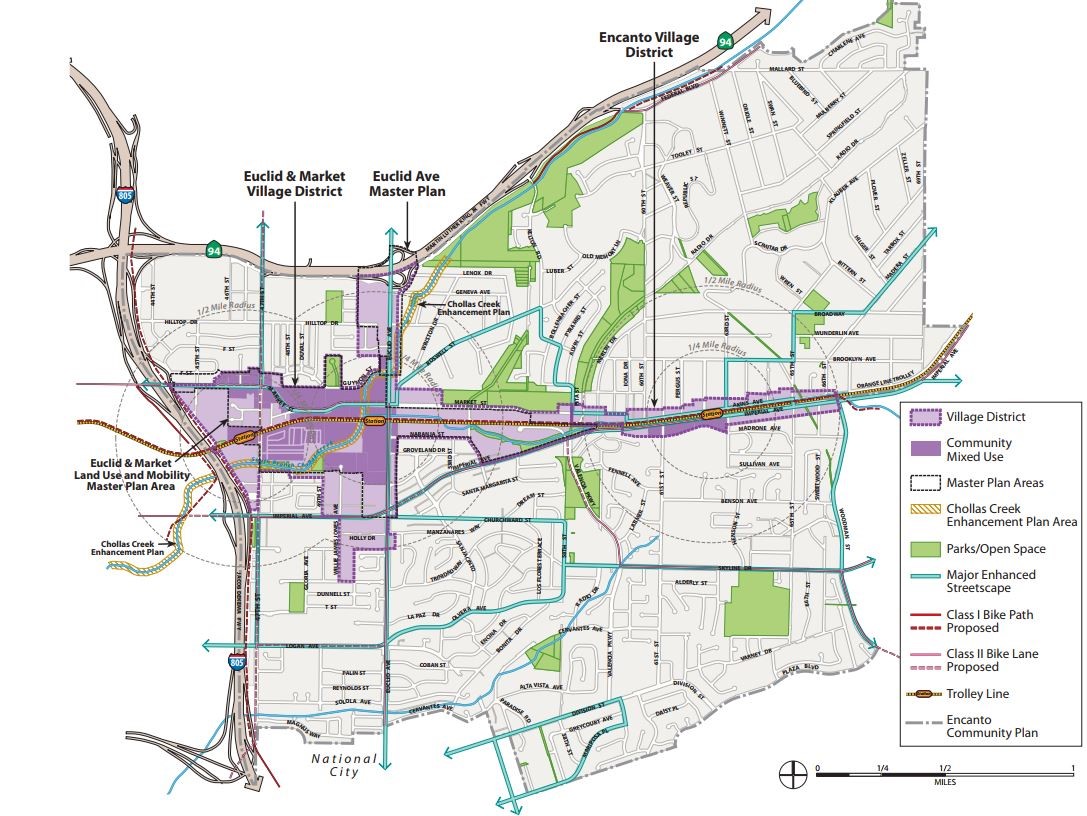
Transit Oriented Development
Case Study – San Diego, CA: Reducing Parking in a Transit-Oriented Neighborhood
Overview
Located in the Encanto neighborhood in eastern San Diego, Villa Encantada is the redevelopment of an underused 163-space parking lot owned by Metropolitan Transit System (MTS) adjacent to a trolley station. It is the first implementation of the Southeast San Diego Community Plan, which calls for mixed-use villages next to transit stations in the Encanto neighborhood.
The need for parking replacement was determined through an independent third-party traffic impact analysis and the application of the City of San Diego’s Municipal Code parking requirements. The project developers requested to use the Transit Area Overlay Zone (TAOZ) Parking Rate, which would allow for a reduction of 0.25 parking spaces per residential unit and a reduction of 4.3 parking spaces per 1,000 square feet of commercial floor space.
The Villa Encantada development has 105 residential, 4 commercial, and 100 public MTS parking spaces. This array includes 95 below-grade residential parking spaces, as well as 14 at-grade podium parking spaces shared between the residential and commercial tenants.

Encanto Neighborhoods Community Plan
Source: https://www.sandiego.gov/sites/default/files/legacy
/planning/community/cpu/encanto/pdf/EncantoCommPlanUpdate.pdf
Policies/Ordinances that Contributed to Project Success
The City of San Diego has reduced parking requirements by 25% spaces per dwelling unit for transit areas or very low-income housing areas within multi-family residential developments, and by as much as 70% spaces per 1000 square foot feet for commercial, office, and mixed land uses. Other policy reforms include: allowing tandem parking and shared parking; provision for a payment in-lieu of providing on-site parking; and provision for electric vehicle, bicycle, and motorcycle parking, as well as alternative transportation incentives such as transit passes.
The Community Plan Implementation Overlay Zone (CPIOZ) supports transportation improvements in a “transit priority area”. In the Encanto Neighborhoods, this plan will foster the integration of transit within mixed-use residential and commercial areas, thereby reducing parking demand.
Outcomes
The City of San Diego planning staff have made the following observations about the challenges of the planning and development process:
- The community was concerned that reduced parking requirements in the neighborhood might cause parking spillover onto their residential streets.
- Some residents thought that too much mixed-use development would draw more cars to the neighborhood streets.
- Reducing street level parking lots from 6.3 acres to 0.3 acres was a challenge because parking garages increase development costs.
- The Encanto Village development has adopted the new mobility plan transit overlay into the parking requirements and has 0.5 parking stalls per residential unit, an important achievement for the City made possible through extensive community outreach and engagement.
Ken Malbrough, community resident and chairman of the Encanto Community Group, has observed that the parking requirements adopted were well-received in the community, partly because transit ridership is high and service is fairly frequent on the trolley line that runs through their neighborhoods. Malbrough also affirmed the importance of community involvement in the planning process to guide growth in a manner that reflects the community’s vision.